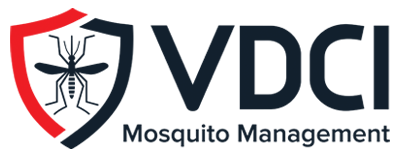As warm weather begins to take hold across North America, many people are itching to get outside and enjoy more seasonal temperatures. However, in the wake of a very wet winter and spring in many parts of the United States, scientists are already raising the red flag about heightened mosquito activity in 2023.
As the climate continues to change, new mosquito species are becoming more prevalent in the United States, particularly in more tropical areas of the country, like Florida and the Gulf Coast states. For example, in March 2023, new research by Larry Reeves from the University of Florida’s Institute of Food and Agricultural Science published in the Journal of Medical Entomology reported on Culex lactator, a mosquito species from South America that is slowly gaining a foothold in Florida. Understanding how fast new species like this are spreading, where they are being found, and how they adapt to new climates is critical to developing control methods.
With the rapid evolution of technology, mosquito researchers are now looking toward ordinary citizens to help gain some of this knowledge, elevating “citizen science” to a new level in helping to understand mosquito activity around the globe. Two new apps, available to anyone using a smartphone or web-enabled tablet, are now making it easier for scientists to track and understand mosquito activity with the help of citizens interested in protecting public health from mosquitoes.
What is citizen science?
The term “citizen science” was first coined in 1989 by researchers at the Massachusetts Institute of Technology (MIT) in describing work being done by community members who were interested in environmental issues.
The Cambridge Dictionary defines citizen science as “scientific work, for example collecting information, that is done by ordinary people without special qualifications, in order to help the work of scientists.”
By this definition, any of us can help enable mosquito research from our communities and even our backyards if we know what to look for and how to report it. That’s where two easily downloadable applications, the Globe Observer app and the Mosquito Alert app, empower everyday citizens to help inform scientists about mosquito activity with just a few taps on their smart devices.
Mosquito Research Safety Precautions
Before using either of the apps in this article, it is important to note that voluntarily engaging in any mosquito research activity can increase your likelihood of being bitten by mosquitoes, which can spread diseases that are harmful to humans and our pets, such as West Nile virus, heartworm, Eastern equine encephalitis (EEE), dengue, and more.
As such, it is important to take safety precautions if you plan to be outside or in any area where mosquitoes are known to be active. Remember the 4Ds to help reduce your chances of being bitten.
- DEFEND – Always protect yourself by using a U.S. Environmental Protection Agency (EPA)-registered insect repellent.
- DRESS – Dress in closed-toe shoes and loose-fitting pants and long-sleeve shirts that are light in color. Avoid wearing perfumes or other scented products that may attract mosquitoes.
- DRAIN – Remove or drain any standing water.
- DAWN AND DUSK – Avoid the outdoors during dawn and dusk hours when mosquitoes are most active.
The Globe Observer App
Powered by the United States National Aeronautic and Space Administration (NASA), the Globe Observer app enables users to enter data and information in 4 different areas: clouds, land cover, trees, and the mosquito habitat mapper. For this blog, we’ll focus on the latter area.
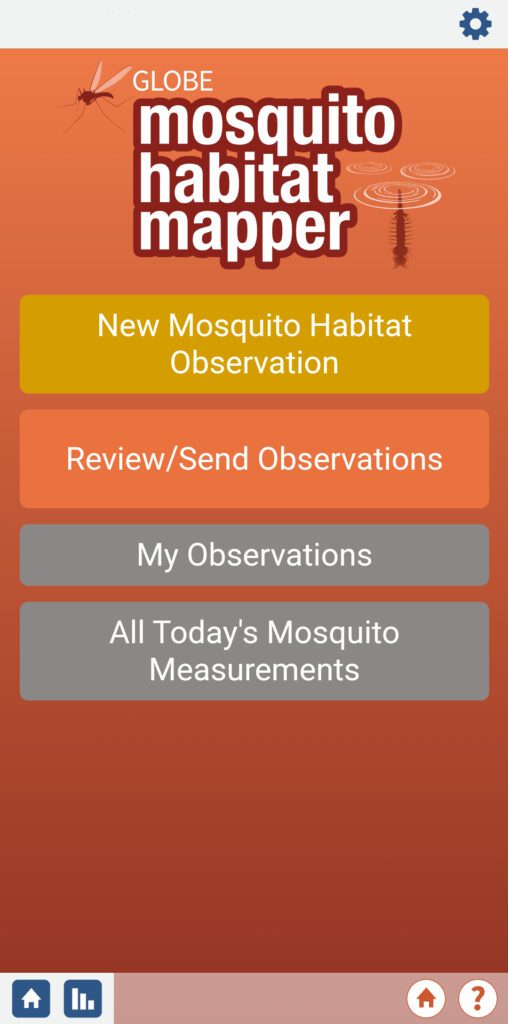
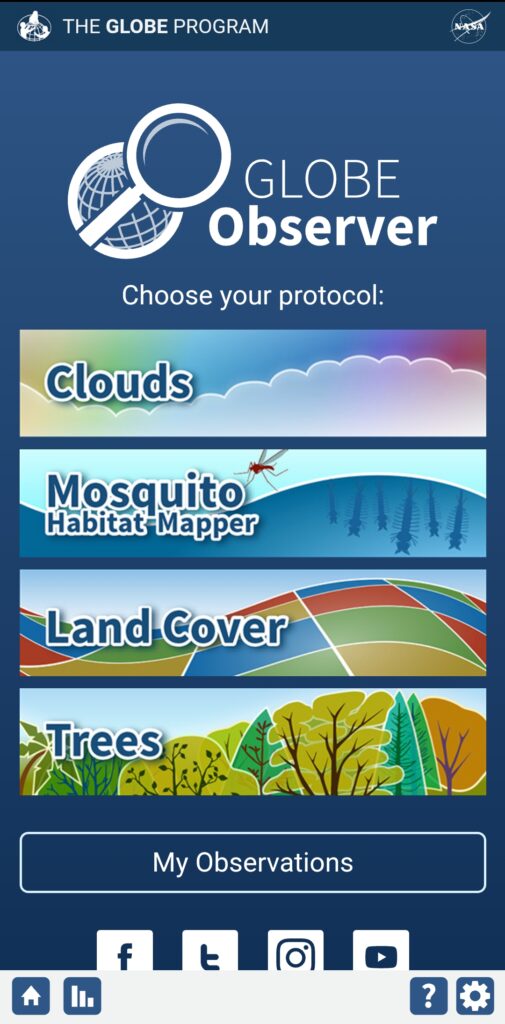
To best use the Globe Observer app, users will need to do the following:
- Download the app to your smart device.
- Create an account using their email address and verify through a password emailed to the supplied email address.
- Enable location services while using the app; this allows for the app to easily help you report mosquito breeding habitats.
- Take photos using your smart device.
- Allow access to your device’s camera for uploading photos of habitats and larvae.
For safety purposes, this app focuses users on recording data related to mosquito breeding sites and larvae rather than tracking adult mosquitoes.
Once users have downloaded the app and created their account, they can use the mosquito habitat mapper to take one of four actions:
- Identify potential mosquito habitats
- Sample and count mosquito larvae (using a cup, bulb syringe, or other container)
- Identify the larva type (may require a microscope or macro lens on your device’s camera)
- Eliminate the larva you have counted and the breeding habitat, if possible
Each of these actions can be taken with a few simple taps, by following the directions provided on each screen.
Users can also view maps of the mosquito observations that other users have made by clicking on the chart icon at the bottom left corner of the screen from anywhere in the app and selecting the See Today’s Mosquito Measurements button. The feature works best when you view it over a cumulative time period. Users can leverage the calendar and zoom features to see further details of activity recorded by other citizen scientists.
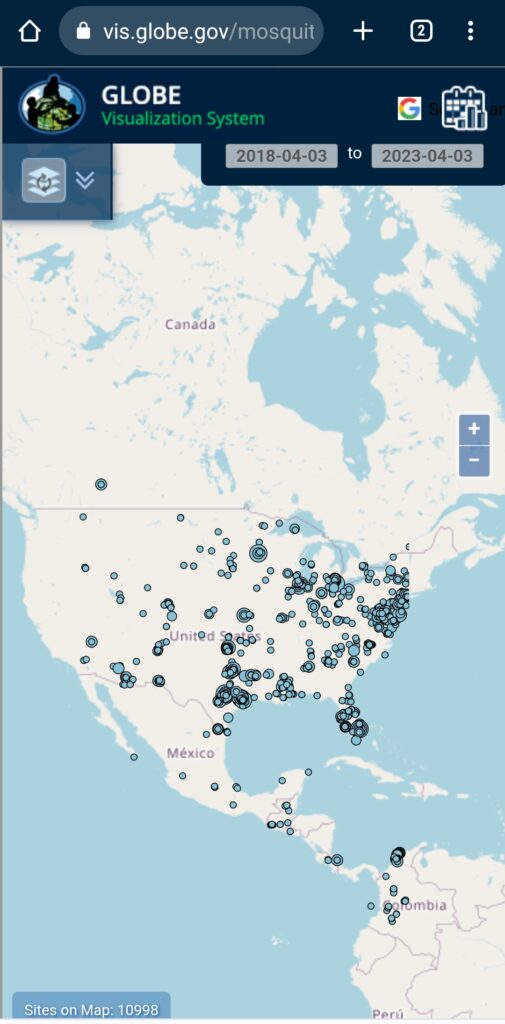
The Mosquito Alert App
A public information project coordinated by four different research organizations, the Mosquito Alert app works similarly to the Globe Observer app to help citizens report a variety of different mosquito-related conditions to help monitor activity in their area. Data for this citizen science project has been recorded since 2014.
The Mosquito Alert app is based internationally in Spain, developed by the Centre for Ecological Research and Forestry Applications (CREAF), Pompeu Fabra University (UPF), Catalan Institution for Research and Advanced Studies (ICREA), and Blanes Center for Advanced Studies (CEAB-CSIC). As such, many of the current users of the app are based in Europe, but the activity maps do reflect some reports in the Americas.
To best use the Mosquito Alert app, users will need to:
- Download the app to your smart device.
- Create an account.
- Enable location services while using the app for mapping purposes.
- Take photos using your smart device.
- Allow access to your device’s camera for uploading photos of mosquitoes, bites, and more.
The Mosquito Alert app is focused specifically on five different mosquito species that are particularly important in the spread of disease to humans.
- Asian tiger mosquito (Aedes albopictus)
- Yellow fever mosquito (Aedes aegypti)
- Japan mosquito (Aedes japonicus)
- Korean mosquito (Aedes koreicus)
- Northern house mosquito (Culex pipiens)
By clicking on the Settings icon at the top left from any screen of the app, users can access an app tutorial on mosquito identification or a Mosquito guide to note distinguishing features that can help identify particular mosquito species, see photo examples of mosquito larvae and breeding sites, and more.
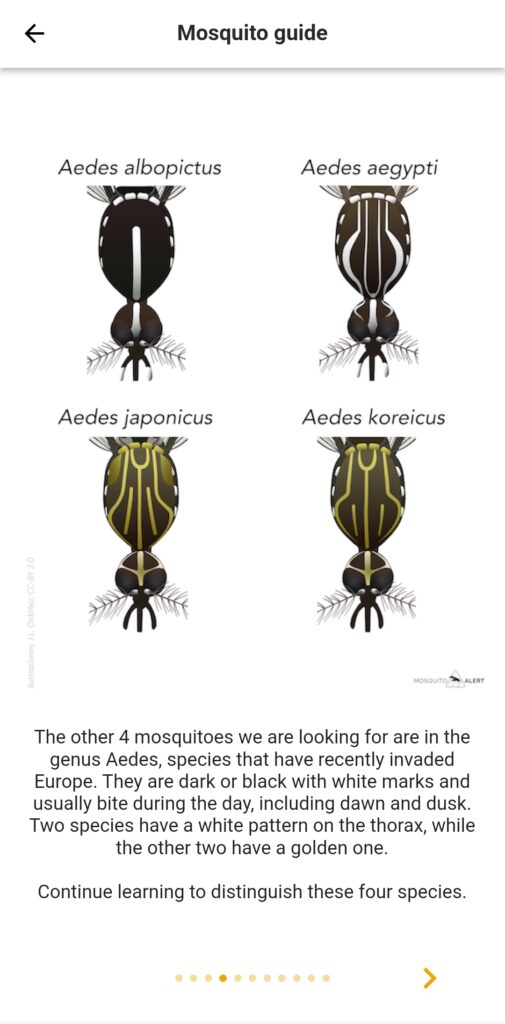
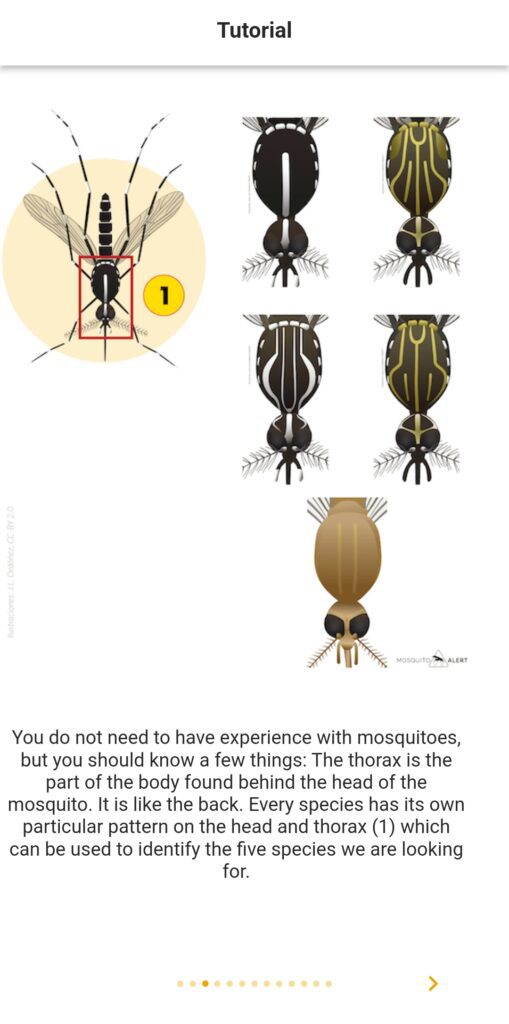
Once users have set up an account, they can use the app to take one of four actions:
- Report a mosquito bite
- Report adult mosquito activity
- Report a breeding site
- Or view data they have submitted
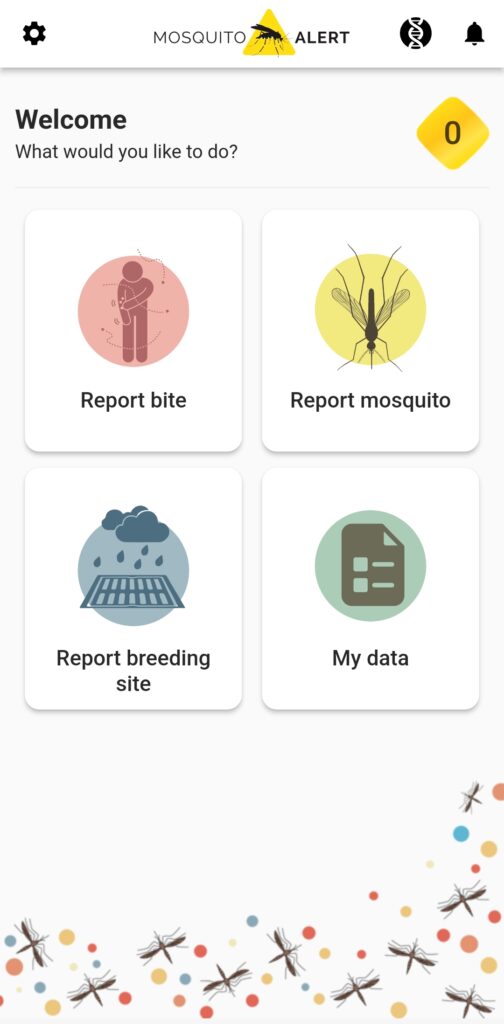
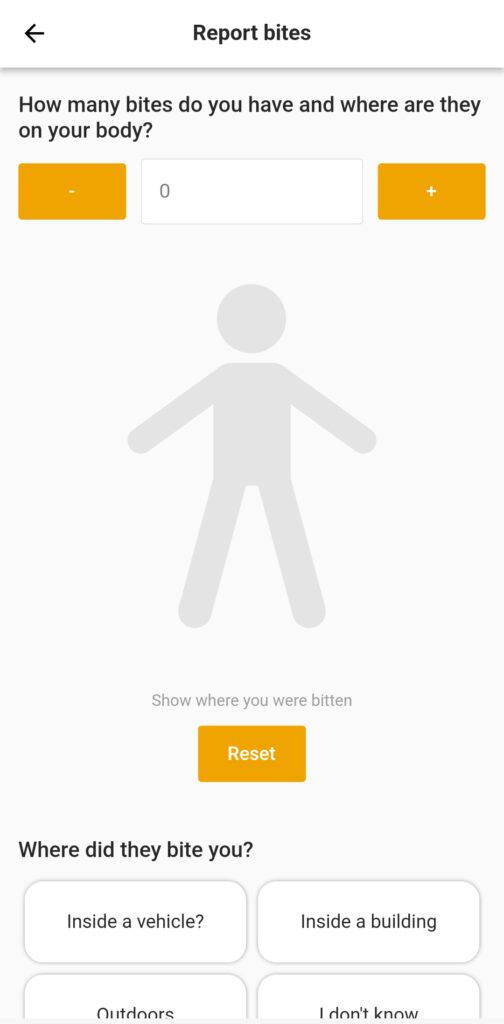
When reporting a bite, users will be asked several questions:
- How many bites they received
- Using a diagram, select where on their body they were bitten
- Select your general location where you were bitten (inside a vehicle, inside a building, outdoors, or do not know)
- When they were bitten
If users use the app to report a breeding site, a different set of questions will appear. They will be asked whether or not the site is a storm drain or another location. For either option, users will be asked to take a photo of the location.
If reporting an adult mosquito, the user will be asked to select the type of mosquito they think it was by species, take a photograph if possible, and mark their location (if location services are enabled on the user’s device, the device will automatically record the location on a map).
As of April 2023, the Mosquito Alert app reports having over 278,000 participants around the world and averages nearly 30 reports from citizen scientists each day.
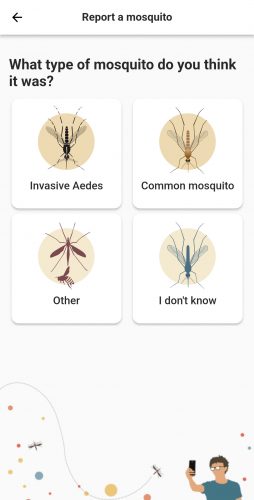
It's Up to Us to Improve The Data
As with any scientific project, data is invaluable. These apps, and the data they provide to mosquito researchers, will get better as more users report mosquito breeding sites and activity near their locations. YOU can be a part of this important citizen science by downloading one or both of these apps and reporting mosquito conditions near you.
If you work with or have children, utilizing these apps can be a great science project and learning opportunity by involving them in STEM (Science, Technology, Engineering, and Mathematics) while they are young.
Don't Forget To Report Mosquitoes To Your Local Authorities
While citizen science apps are a helpful tool for global research, it’s important to remember to report mosquito breeding sites and unusual mosquito activity to local authorities in your community. This will ensure the quickest and most effective action is taken to reduce the risks mosquitoes pose to you, your family, your neighbors, and your community at large.
While the authority you should report activity to varies by community, calling your local mosquito control board or health department is typically a great start. In some communities, you may be able to call 311 and ask about reporting mosquitoes to get you to the right resources.
Implementing Integrated Mosquito Management in Your Community
VDCI is proud to partner with government agencies, municipalities, and businesses across the United States to help reduce mosquito populations and eliminate risks in their communities. For more information on our programs, implementing an Integrated Mosquito Management program in your community, and other helpful resources, visit vdci.net.
Contact Us to Learn More About Effective Mosquito Prevention Strategies:
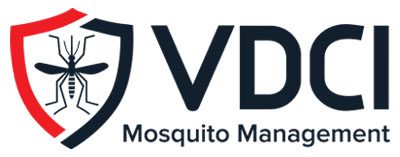 Since 1992, Vector Disease Control International (VDCI) has taken pride in providing municipalities, mosquito abatement districts, industrial sites, planned communities, homeowners associations, and golf courses with the tools they need to run effective mosquito control programs. We are determined to protect the public health of the communities in which we operate. Our mosquito control professionals have over 100 years of combined experience in the field of public health, specifically vector disease control. We strive to provide the most effective and scientifically sound mosquito surveillance and control programs possible based on an Integrated Mosquito Management approach recommended by the American Mosquito Control Association (AMCA) and Centers for Disease Control and Prevention (CDC). VDCI is the only company in the country that can manage all aspects of an integrated mosquito management program, from surveillance to disease testing to aerial application in emergency situations.
Since 1992, Vector Disease Control International (VDCI) has taken pride in providing municipalities, mosquito abatement districts, industrial sites, planned communities, homeowners associations, and golf courses with the tools they need to run effective mosquito control programs. We are determined to protect the public health of the communities in which we operate. Our mosquito control professionals have over 100 years of combined experience in the field of public health, specifically vector disease control. We strive to provide the most effective and scientifically sound mosquito surveillance and control programs possible based on an Integrated Mosquito Management approach recommended by the American Mosquito Control Association (AMCA) and Centers for Disease Control and Prevention (CDC). VDCI is the only company in the country that can manage all aspects of an integrated mosquito management program, from surveillance to disease testing to aerial application in emergency situations.

